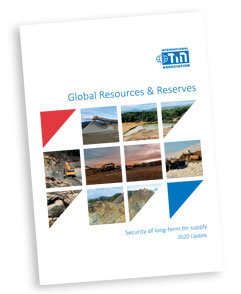2020 Report on Global Tin Resources & Reserves
The long-term supply of materials remains a top priority for downstream users and policy makers. If a material appears to be running out, it may be labelled as “critical”. For many, this can destroy demand through substitution. Long-term stability of supply can be assessed through the available resources and reserves of a mineral. This report presents ITA’s estimate of global tin resources and reserves at the end of 2019, with commentary and outlook for the important tin producing regions of the present, and potentially the future.
In summary:
- According to ITA calculations, the world’s reported tin resources at the end of 2019 totalled some 15.4 Mt, including some 5.5 Mt of reserves. Of this, some 39% (6.0 Mt) of resources and 29% (1.6 Mt) of reserves were compliant with CRIRSCO standards.
- The top five countries as a proportion of global compliant resources were Russia (29%), Australia (15%), Peru (9%), DR Congo (9%) and Brazil (8%). When non-compliant resources are
included, the top five countries become China (38%), Russia (11%), Australia (7%), Indonesia (7%) and Bolivia (4%). - When considering just the defined tin resources, current demand levels can be supported for another 50 years. However, the potential of unreported and undiscovered tin worldwide is enough to support demand long into the future. However, many defined tin resources will require higher tin prices or more efficient extraction technologies to become economic for development.
- The current low tin price represents a risk to short-term supply due to reduced investment in tin projects. However, it is important to clarify that this is unrelated to the amount of metal in the ground.

